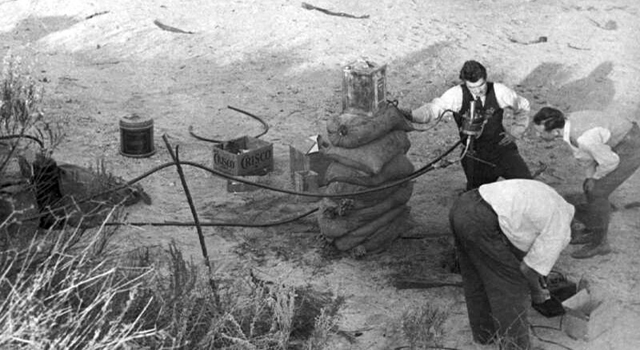NASA's Rocket Legacy: 75 Years of Space Engine Tests

Monday (Oct. 31) marked the 75th anniversary of NASA's venerable Jet Propulsion Lab in Pasadena, Calif., which began when a ragtag group of rocket scientists conducted one of the first tests of a liquid-fueled rocket motor in the dry riverbed of the Arroyo Seco.
The story is told in a 90-minute documentary called "The American Rocketeer," the first episode in a new trilogy about the history of the Jet Propulsion Lab (JPL). The first episode will air Thursday, Nov. 3 at 9 p.m. PDT on California's KCET channel.
The 1936 rocket team had chosen the location "because, there, they most likely would not kill anyone — except perhaps themselves," according to a JPL statement.
The rocketeers — Frank Malina, Jack Parsons, Ed Forman, A.O. Smith, William Bollay, Carlos Wood and William Rockefeller — were most mostly graduate students at nearby Caltech. They'd spent nine months working on their rocket motor, hoping for a breakthrough in rocket propulsion. [Could the U.S. Have Beaten the Soviet Union Into Space?]
The contraption was nearly five feet tall, made of duralumin, surrounded by a water jacket to keep the combustion chamber cool.
"The rocket nozzle pointed skyward and, when firing, the plan was it would push down on a diamond-tipped arm that would scratch a clock-driven glass drum, providing the experimenters with an accurate assessment of the motor's thrust," JPL officials describe. "All this was attached by a series of rubber tubes to a mélange of valves, flow meters, pressure regulators, pressurized bottles of fuel and oxidizer, and surrounded by sandbags."
With the experiment set up, the scientists huddled behind a wall of sandbags and hid in the back of a nearby trash dump. They lit the fuse and waited anxiously, until … nothing.
Get the Space.com Newsletter
Breaking space news, the latest updates on rocket launches, skywatching events and more!
The first try didn't work. Neither did the second or third. But a fourth and final try that day successfully lit the fuse and set off the engine, creating a footlong plume of fire.
It was not just a beginning for liquid powered rocket engines, but the arrival of the space age in Pasadena.
"Today, space probes designed, built and managed within earshot of that first Arroyo rocket firing have reached every planet in our solar system and peered well beyond its boundaries," JPL officials wrote. "Each probe carries with it the legacy of scientific and engineering excellence that began some three-quarters of a century ago in an isolated, scrub-strewn gulch in the Arroyo."
Follow SPACE.com for the latest in space science and exploration news on Twitter @Spacedotcom and on Facebook.
Join our Space Forums to keep talking space on the latest missions, night sky and more! And if you have a news tip, correction or comment, let us know at: community@space.com.

Space.com is the premier source of space exploration, innovation and astronomy news, chronicling (and celebrating) humanity's ongoing expansion across the final frontier. Originally founded in 1999, Space.com is, and always has been, the passion of writers and editors who are space fans and also trained journalists. Our current news team consists of Editor-in-Chief Tariq Malik; Editor Hanneke Weitering, Senior Space Writer Mike Wall; Senior Writer Meghan Bartels; Senior Writer Chelsea Gohd, Senior Writer Tereza Pultarova and Staff Writer Alexander Cox, focusing on e-commerce. Senior Producer Steve Spaleta oversees our space videos, with Diana Whitcroft as our Social Media Editor.









